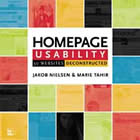|
Authors: Jakob Nielsen and Marie Tahir
 
See it on Amazon
 In the follow-up to his successful book Designing Web Usability, Jakob Nielsen teams up with Marie Tahir to bring us Homepage Usability. If you're wondering how the two books relate, Designing Web Usability covers the general usability of websites and Homepage Usability strictly covers homepages. The homepage is typically the first page visitors come to on a website and it deserves its own book. In the follow-up to his successful book Designing Web Usability, Jakob Nielsen teams up with Marie Tahir to bring us Homepage Usability. If you're wondering how the two books relate, Designing Web Usability covers the general usability of websites and Homepage Usability strictly covers homepages. The homepage is typically the first page visitors come to on a website and it deserves its own book.
If you're thinking this is just another book pointing out the obvious when it comes to usability, you're only half right. Nielsen and Tahir lay out 113 rules to make any homepage usable. That's right, 113. While some of the rules are very obvious like including the company logo on a page and clearly communicating the site's purpose, others, like making a search box 25 characters in length, are not so obvious.
As opposed to just giving a list of rules and wishing the reader the best of luck with their homepages, the authors have taken 50 sites and critiqued their homepages based on the rules. The list of sites is an impressive one including Amazon.com, Boeing.com, and Disney.com. According to the authors, the sites were chosen 'because they were prominent in some way: Most sites came from top-10 lists of most-visited sites in the U.S. and other countries, as well as lists of the world's largest companies. We also included the sites of a few prominent government agencies and some well-run small companies and non-profit institutions.' Most of the sites reviewed are famous as I had heard of at least 40 of them.
The Good, the Bad, and the Ugly
The reviews themselves are very extensive. It's amazing to see what simple usability rules popular sites break. A sample of poor usability in action is About.com's tagline. At the time this book was written, their tagline was 'The Human Internet'. While that is cute, that doesn't give the visitor any clue as to what About.com is' about. (Interesting Note: Since the publishing of this book, About.com has changed their tagline to 'What You Need to Know'. Although this isn't the best of taglines, it's much better than 'The Human Internet'.)
Other mishaps include a variety of blunders such as misspellings, inconsistent text formatting, vague text, misplacement of logos, confusing links, pointless animation, and even random pictures that have nothing to do with the company.
The authors cover the good aspects of the homepage as well as the bad. While none of the sites critiqued were the 'perfect site', most of them excelled in certain areas. The authors were just as quick to point out these areas as well as the areas needing improvement. This was extremely helpful. While some of the authors' sarcastic comments concerning unusable homepage features can be entertaining as well as educational, the reader needs to see some of these 113 rules used correctly.
What this book was missing
Homepage Usability is lacking several aspects that are keeping it from being a five star book. The first missing aspect is that the authors provide no method to giving these homepages a grade. This was later made up for on Nielsen's website where he goes into detail on how to grade a homepage using the rules from the book. I'm just not sure why this wasn't in the book.
The next two aspects are related to the previous. While the authors went through the homepages extensively pointing out every usability item they could find, they did not give any of the sites an overall grade. Along with grading the sites, a numerical list of all fifty sites (The most usable to the least usable) would have been very helpful as well as interesting to see in this book. Knowing which homepage would have scored the highest against the other homepages would help readers in learning usability.
Overall
Even with the missing aspects, a lot of work was put into the writing of this book. In fact, there is so much information that Homepage Usability serves more like a classroom textbook. I will be keeping my copy on my shelf for reference.
Looking at my own homepage, I've realized that I need to work on some usability. I'm going to be critiquing my homepage using the book's rules and Nielsen's grading method. The results will be posted on this site.
|
